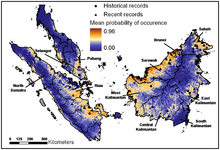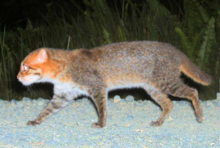Flat-headed cat: Difference between revisions
BhagyaMani (talk | contribs) →Conservation: moved some info to new section →Threats: extended with ref |
BhagyaMani (talk | contribs) completed list of authors in ref wilting+al2010; moved out of taxobox |
||
| Line 17: | Line 17: | ||
| range_map = Plionailurus planiceps former distribution.png |
| range_map = Plionailurus planiceps former distribution.png |
||
| range_map_alt = Map showing Peninsular Malaysia, Sumatra and Borneo |
| range_map_alt = Map showing Peninsular Malaysia, Sumatra and Borneo |
||
| range_map_caption = Range of Flat-headed Cat<ref name="wilting+al2010" |
| range_map_caption = Range of Flat-headed Cat<ref name="wilting+al2010"/> |
||
}} |
}} |
||
| Line 32: | Line 32: | ||
== Distribution and habitat == |
== Distribution and habitat == |
||
[[File:Plionailurus planiceps cropped.png|thumb|Flat-headed Cat [[Camera trap|camera-trap]]ped in Tangkulap Forest Reserve, Sabah, Malaysia in March 2009]] |
[[File:Plionailurus planiceps cropped.png|thumb|Flat-headed Cat [[Camera trap|camera-trap]]ped in Tangkulap Forest Reserve, Sabah, Malaysia in March 2009]] |
||
The distribution of flat-headed cats is restricted to lowland [[tropical rainforest]]s in extreme southern [[Thailand]], [[Peninsular Malaysia]], [[Sabah]], [[Sarawak]], [[Brunei Darussalam]], [[Kalimantan]] and [[Sumatra]]. They primarily occur in [[freshwater]] habitats near coastal and lowland areas. More than 70% of records were collected less than {{convert|3|km|mi}} away from water.<ref name="wilting+al2010"/> |
The distribution of flat-headed cats is restricted to lowland [[tropical rainforest]]s in extreme southern [[Thailand]], [[Peninsular Malaysia]], [[Sabah]], [[Sarawak]], [[Brunei Darussalam]], [[Kalimantan]] and [[Sumatra]]. They primarily occur in [[freshwater]] habitats near coastal and lowland areas. More than 70% of records were collected less than {{convert|3|km|mi}} away from water.<ref name="wilting+al2010">Wilting, A., Cord, A., Hearn, A. J., Hesse, D., Mohamed A., Traeholdt, C., Cheyne, S. M., Sunarto, S., Jayasilan, M., Ross, J., Shapiro, A. C., Sebastian, A., Dech, S., Breitenmoser, C., Sanderson, J., Duckworth, J. W., Hofer, H. (2010) [http://www.plosone.org/article/info%3Adoi%2F10.1371%2Fjournal.pone.0009612 "Modelling the Species Distribution of Flat-Headed Cats (''Prionailurus planiceps''), an Endangered South-East Asian Small Felid"]. [[PLoS ONE]] 5 (3): e9612. {{doi|10.1371/journal.pone.0009612}}</ref> |
||
Flat-headed cats occur in both [[primary forest|primary]] and [[secondary forest]].<ref name=Borneo>Payne, J., Françis, C. M., Phillipps, K. (1998) ''A Field Guide to the Mammals of Borneo.'' Sabah Society. 3rd reprint, ISBN 967-99947-1-6</ref> |
Flat-headed cats occur in both [[primary forest|primary]] and [[secondary forest]].<ref name=Borneo>Payne, J., Françis, C. M., Phillipps, K. (1998) ''A Field Guide to the Mammals of Borneo.'' Sabah Society. 3rd reprint, ISBN 967-99947-1-6</ref> |
||
Revision as of 20:50, 13 October 2011
| Flat-headed Cat[1] | |
|---|---|

| |
| Scientific classification | |
| Kingdom: | |
| Phylum: | |
| Class: | |
| Order: | |
| Family: | |
| Genus: | |
| Species: | P. planiceps
|
| Binomial name | |
| Prionailurus planiceps | |

| |
| Range of Flat-headed Cat[3] | |
The Flat-headed Cat (Prionailurus planiceps) is a small wild cat patchily distributed in the Thai-Malay Peninsula, Borneo and Sumatra. Since 2008, it has been listed as Endangered by the IUCN due to destruction of wetlands in their habitat.[2]
This cat is very rare in captivity, with less than 10 individuals – all in zoos in southeast Asia – recorded by ISIS in early 2010.[4] Like some other small cats, it was originally placed in the genus Felis, but is now considered one of the five species in Prionailurus.[1][5]
Charactersitics
The flat-headed cat has a thick fur that is generally dark reddish-brown tinged grey, with a more reddish head and whitish underparts. Except for the relatively faint facial streaks, it is rather unpatterned. The legs are fairly short, and the ears are short and round. Its name comes from its flattened head.[6] It has a head-and-body length of 41 to 50 cm (16 to 20 in) and a short tail of 13 to 15 cm (5.1 to 5.9 in).[5] It weighs 1.5 to 2.5 kg (3.3 to 5.5 lb).[7]
The inter-digital webs on its paws help the cat gain better traction in muddy environments and water, and are even more pronounced on this cat than those on the paws of the fishing cat. The claws are only partially retractile. The shape of the head is atypical for a cat; the skull is fairly long, while the skull roof, as suggested by both its common and scientific name, is rather flat.[8] The eyes are unusually far forward and close together, compared with other cats, giving the animal improved stereoscopic vision. In addition, the teeth are adapted for gripping onto slippery prey, and the jaws are relatively powerful. These features help the flat-headed cat to catch and retain aquatic prey, to which it is at least as well adapted as the closely related fishing cat.[6]
Distribution and habitat

The distribution of flat-headed cats is restricted to lowland tropical rainforests in extreme southern Thailand, Peninsular Malaysia, Sabah, Sarawak, Brunei Darussalam, Kalimantan and Sumatra. They primarily occur in freshwater habitats near coastal and lowland areas. More than 70% of records were collected less than 3 kilometres (1.9 mi) away from water.[3]
Flat-headed cats occur in both primary and secondary forest.[9]
Ecology and behavior
The Flat-headed Cat is generally considered a nocturnal animal, but observations of captives suggests it is crepuscular.[10] It mostly hunts for frogs, fish and crustaceans, but will also catch rats and chickens.[5][8] In captivity, they show much greater interest in potential prey in the water than that on dry land, suggesting a strong preference for riverine hunting in their natural habitat.[6]
It has relatively long premolars, and is one of the few cats that is unable to completely retract its claws (the others being the Cheetah, Fishing Cat, and the Iriomote Cat). These adaptions combined with its behavior have resulted in comparisons with semi-aquatic mustelids, and it is known for readily entering water.[8]
In the wild, flat-headed cats are solitary, and scent mark their territory. Unlike other cats, however, they spray urine by walking forward in a crouching position, leaving a trail on the ground, rather than directing it onto a vertical surface. They appear to have similar vocalisations to the Domestic Cat.[6]
Overall, however, little is known about its wild behavior,[7] but a gestation period of about 56 days, and a litter size of 1-2 kittens have been reported in captivity.[10] Captive individuals have lived for fourteen years.[8]
Threats
Flat-headed cats are primarily threatened by wetland and lowland forest destruction and degradation.[8] Causes of this destruction include human settlement, forest transformation to plantations, draining for agriculture, pollution, and excessive hunting, wood-cutting and fishing. In addition, clearance of coastal mangroves over the past decade has been rapid in tropical Asia. The depletion of fish stocks from over-fishing is prevalent in many Asian wetland environments and is likely to be a significant threat. Expansion of oil palm plantations is currently viewed as the most urgent threat.[2]
They are also threatened by trapping, snaring and poisoning.[6] They have been captured in traps set out to protect domestic fowl.[8]
Conservation
The flat-headed cat is included on CITES Appendix I.[2] The felid is fully protected by national legislation over its range, with hunting and trade prohibited in Indonesia, Malaysia, and Thailand.[8]
References
- ^ a b Wozencraft, W. C. (2005). "Order Carnivora". In Wilson, D. E.; Reeder, D. M. (eds.). Mammal Species of the World: A Taxonomic and Geographic Reference (3rd ed.). Johns Hopkins University Press. p. 543. ISBN 978-0-8018-8221-0. OCLC 62265494.
- ^ a b c d Template:IUCN
- ^ a b Wilting, A., Cord, A., Hearn, A. J., Hesse, D., Mohamed A., Traeholdt, C., Cheyne, S. M., Sunarto, S., Jayasilan, M., Ross, J., Shapiro, A. C., Sebastian, A., Dech, S., Breitenmoser, C., Sanderson, J., Duckworth, J. W., Hofer, H. (2010) "Modelling the Species Distribution of Flat-Headed Cats (Prionailurus planiceps), an Endangered South-East Asian Small Felid". PLoS ONE 5 (3): e9612. doi:10.1371/journal.pone.0009612
- ^ International Species Information System. Captive Prionailurus planiceps. Accessed 2010-04-16
- ^ a b c Nowak, R. (editor) 1999. Walker's Mammals of the World. 6th edition. ISBN 0-8018-5789-9
- ^ a b c d e Sunquist, M., Sunquist, F. (2002). Wild Cats of the World. The University of Chicago Press. pp. 233–236. ISBN 0-226-77999-8.
{{cite book}}: CS1 maint: multiple names: authors list (link) - ^ a b Francis, C. (2001) A Photographic Guide to Mammals of South-east Asia including Thailand, Malaysia, Singapore, Myanmar, Laos, Cambodia, Vietnam, Java, Sumatra, Bali and Borneo. ISBN 85974 507 5
- ^ a b c d e f g Nowell, K., Jackson, P. (1996) Flat-headed Cat. Prionailurus planiceps. In: Wild Cats: status survey and conservation action plan. IUCN/SSC Cat Specialist Group, Gland, Switzerland.
- ^ Payne, J., Françis, C. M., Phillipps, K. (1998) A Field Guide to the Mammals of Borneo. Sabah Society. 3rd reprint, ISBN 967-99947-1-6
- ^ a b ARKive: Flat-headed cat (Prionailurus planiceps). Accessed 2008-04-04

